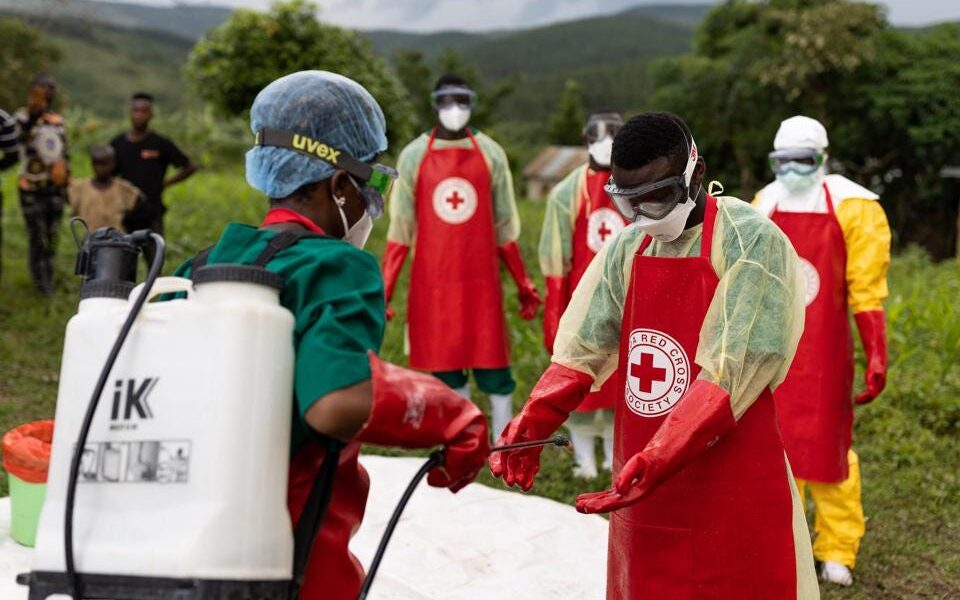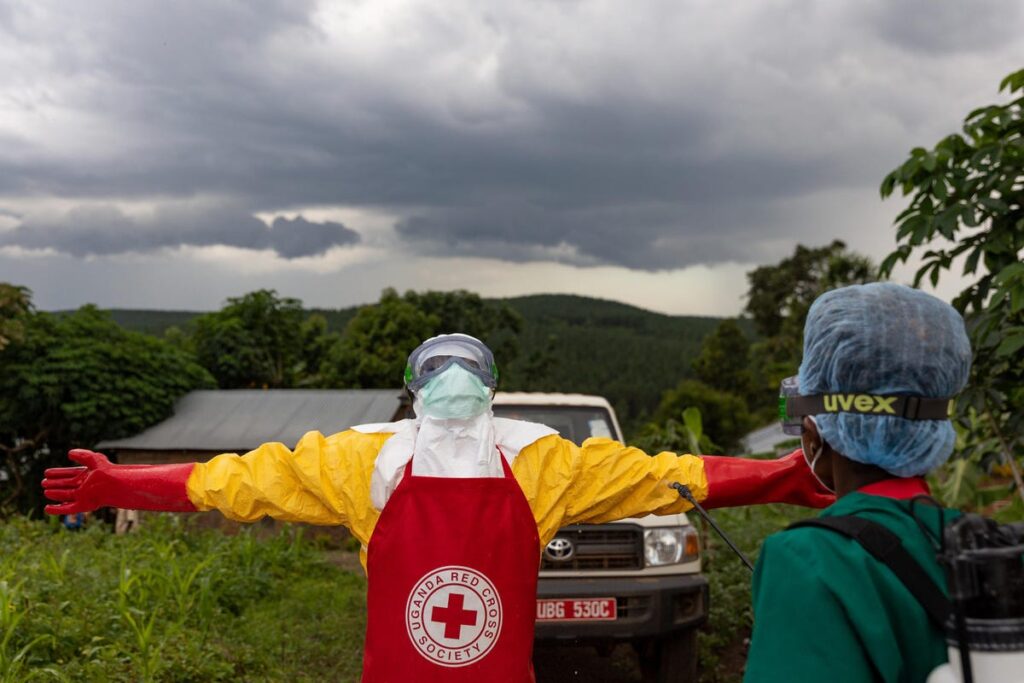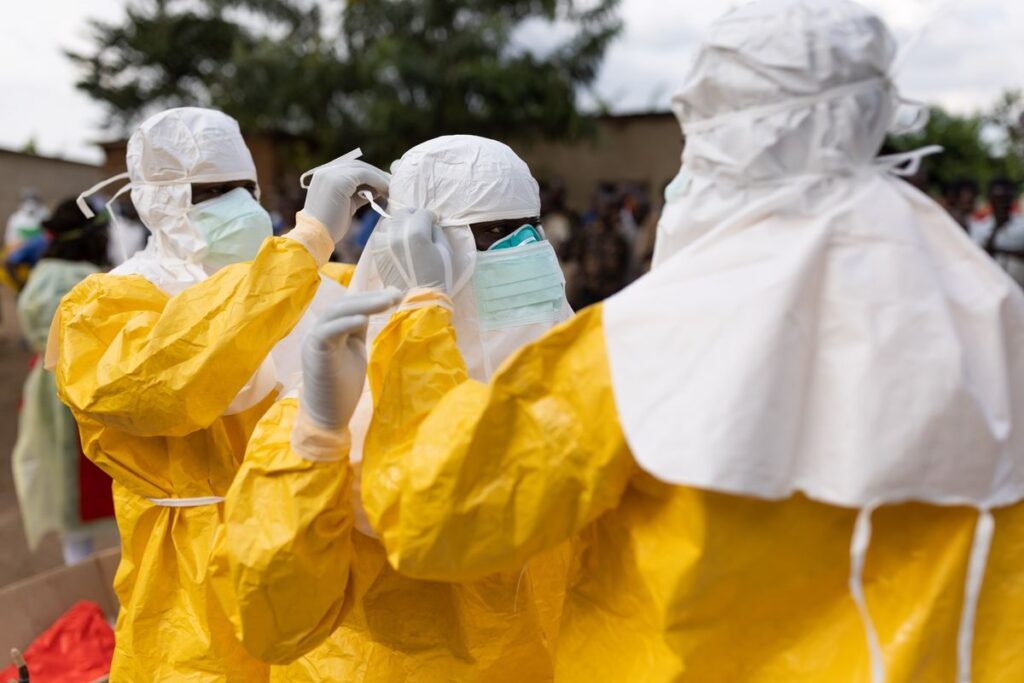Ebola Virus Disease (EVD) is a rare and deadly disease in people and primates. The viruses that cause Ebola are located mainly in sub-Saharan Africa. People can get Ebola through direct contact with an infected animal (bat or primate) or a sick or dead person infected with the Ebola virus.
Quick Links to what you need to know about Ebola:
- What is the Ebola virus Disease (EVD)?
- How is Ebola Virus Transmitted?
- Who is at risk of catching the Ebola Virus Disease?
- How persistent is the Ebola Virus Disease?
- Is there an approved Vaccine for Ebola Virus Disease (EVD)?
- What are the known symptoms of the Ebola Virus Disease?
Ebola virus disease (EVD) is a deadly disease with occasional outbreaks that occur mostly on the African continent. EVD most commonly affects people and nonhuman primates (such as monkeys, gorillas, and chimpanzees). It is caused by an infection with a group of viruses within the genus Ebolavirus:
- Ebola virus (species Zaire ebolavirus)
- Sudan virus (species Sudan ebolavirus)
- Taï Forest virus (species Taï Forest ebolavirus, formerly Côte d’Ivoire ebolavirus)
- Bundibugyo virus (species Bundibugyo ebolavirus)
- Reston virus (species Reston ebolavirus)
- Bombali virus (species Bombali ebolavirus)
Of these, only four (04); Ebola, Sudan, Taï Forest, and Bundibugyo viruses have caused the disease to people. Reston virus can cause disease in nonhumans (primates and pigs, but there have not been cases in people. Bombali virus was first identified in bats in 2018, and experts do not know yet if it causes disease in either animals or people.
The Ebola virus was first discovered in 1976 near the Ebola River in what is now the Democratic Republic of Congo. Since then, the virus has been infecting people from time to time, leading to outbreaks in several African countries. Scientists do not know where the Ebola virus comes from. Based on similar viruses, they believe EVD is animal-borne, with bats or nonhuman primates being the most likely source. Infected animals carrying the virus can transmit it to other animals, like apes, monkeys, duikers, and humans.
The virus first spreads to people through direct contact with the blood, body fluids, and tissues of animals. The Ebola virus then spreads to other people through direct contact with the body fluids of a person who is sick with or has died from EVD. This can occur when a person touches these infected body fluids or objects that are contaminated with them. The virus then gets into the body through broken skin or mucous membranes in the eyes, nose, or mouth. People can get the virus through sexual contact with someone who is sick with or has recovered from EVD. The virus can persist in certain body fluids, like semen, after recovery from the illness.
Ebola survivors may experience side effects after their recovery. These may include tiredness, muscle aches, eye and vision problems, and stomach pain.
How is Ebola Virus Transmitted?
Scientists think people are initially infected with the Ebola virus through contact with an infected animal, such as a fruit bat or nonhuman primate. This is called a spillover event. After that, the virus spreads from person to person, potentially affecting a large number of people.
The virus spreads through direct contact (such as through broken skin or mucous membranes in the eyes, nose, or mouth) with:
- Blood or body fluids (urine, saliva, sweat, feces, vomit, breast milk, amniotic fluid, and semen) of a person who is sick with or has died from Ebola virus disease (EVD).
- Objects (such as clothes, bedding, needles, and medical equipment) contaminated with body fluids from a person who is sick with or has died from EVD.
- Infected fruit bats or nonhuman primates (such as apes and monkeys).
- Semen from a man who recovered from EVD (through oral, vaginal, or anal sex). The virus can remain in certain body fluids (including semen) of a patient who has recovered from EVD, even if they no longer have symptoms of severe illness. There is no evidence that Ebola can be spread through sex or contact with vaginal fluids from a woman who had Ebola.
When people become infected with Ebola, they do not start developing signs or symptoms right away. This period between exposure to an illness and having symptoms is known as the incubation period. A person can only spread Ebola to other people after they develop signs and symptoms of Ebola.
Additionally, the Ebola virus is not known to be transmitted through food. However, in certain parts of the world, the Ebola virus may spread through the handling and consumption of wild animal meat or hunted wild animals infected with Ebola. There is equally no evidence that mosquitoes or other insects can transmit the Ebola virus.
Who is at risk of catching the Ebola Virus Disease?
- Health workers who do not use proper infection control while caring for Ebola patients, and family and friends in close contact with Ebola patients, are at the highest risk of getting sick. Ebola can spread when people come into contact with infected blood or body fluids.
- Ebola poses little risk to travelers or the general public who have not cared for or been in close contact (within 3 feet or 1 meter) with someone sick with Ebola.
How persistent is the Ebola Virus Disease?
The virus can remain in areas of the body that are immunologically privileged sites after acute infection. These are sites where viruses and pathogens, like the Ebola virus, are shielded from the survivor’s immune system, even after being cleared elsewhere in the body. These areas include the testes, interior of the eyes, placenta, and central nervous system, particularly the cerebrospinal fluid. Whether the virus is present in these body parts and for how long varies by a survivor. Scientists are now studying how long the virus stays in these body fluids among Ebola survivors.
During an Ebola outbreak, the virus can spread quickly within healthcare settings (such as clinics or hospitals). Clinicians and other healthcare personnel providing care should use dedicated, preferably disposable, medical equipment. Proper cleaning and disposal of instruments such as needles and syringes are important. If instruments are not disposable, they must be sterilized before using again.
The Ebola virus can survive on dry surfaces, like doorknobs and countertops for several hours; in body fluids like blood, the virus can survive up to several days at room temperature. Cleaning and disinfection should be performed using a hospital-grade disinfectant.
Prevention & Vaccines for the deadly Ebola Virus Disease (EVD)
Ebola virus disease (EVD) is a very rare disease that can cause illness in people. It is believed to occur naturally in specific animal populations that live in multiple sub-Saharan African countries. In the areas where EVD is most common, the Ebola virus is believed to spread at low rates among certain animal populations. Occasionally people become sick with Ebola after coming into contact with infected animals, which can lead to Ebola outbreaks in people who come in contact with them or others who have EVD.
When living in or traveling to a region where the Ebola virus is potentially present, there are a number of ways to protect yourself and prevent the spread of EVD.
- Avoid contact with blood and body fluids (such as urine, feces, saliva, sweat, vomit, breast milk, amniotic fluid, semen, and vaginal fluids) of people who are sick.
- Avoid contact with semen from a man who has recovered from EVD, until testing shows that the virus is gone from his semen.
- Avoid contact with items that may have come in contact with an infected person’s blood or body fluids (such as clothes, bedding, needles, and medical equipment).
- Avoid funeral or burial practices that involve touching the body of someone who died from EVD or suspects of EVD.
- Avoid contact with bats, forest antelopes, and nonhuman primates (such as monkeys and chimpanzees) blood, fluids, or raw meat prepared from these or unknown animals (bushmeat).
These same prevention methods should be used when living in or traveling to an area experiencing an Ebola outbreak. After returning from an area experiencing an Ebola outbreak, people should monitor their health for at least 21 days and or seek medical care immediately if they develop symptoms of EVD.
The U.S. Food and Drug Administration (FDA) has approved the Ebola vaccine, ERVEBO®, for the prevention of EVD. ERVEBO vaccine has been found to be safe and protective against only the Zaire ebolavirus species of ebolavirus.
This vaccine is given as a single dose vaccine and has been found to be safe and protective against Zaire ebolavirus, which has caused the largest and most deadly Ebola outbreaks to date.
On February 26, 2020, the Advisory Committee on Immunization Practices (ACIP) recommended pre-exposure prophylaxis vaccination with rVSV-ZEBOV for adults ≥ 18 years of age in the U.S. population who are at potential occupational risk of exposure to Zaire ebolavirus. This recommendation includes adults who are
- Responding or planning to respond to an outbreak of EVD;
- Laboratorians or other staff working at biosafety-level 4 facilities that work with live Ebola virus in the United States; or
- Healthcare personnel working at federally designated Ebola Treatment Centers [PDF – 1 MB] in the United States.
For healthcare providers looking for information about the Ebola vaccine and vaccinating ACIP recommended groups, visit Ebola Vaccine: Information about Ervebo®.
A two-dose vaccine regimen of a different vaccine that was also designed to protect against the Zaire ebolavirus species of Ebola was used under a research protocol in 2019 during an Ebola outbreak in the Democratic Republic of the Congo. The two doses of this vaccine use two different vaccine components (Ad26.ZEBOV and MVA-BN-Filo) and the regimen requires an initial dose and a “booster” dose 56 days later. This vaccine has not yet been approved by the FDA for routine use.
What are the known symptoms of the Ebola Virus Disease?
Symptoms may appear anywhere from 2 to 21 days after contact with the virus, with an average of 8 to 10 days. The course of the illness typically progresses from “dry” symptoms initially (such as fever, aches and pains, and fatigue), and then progresses to “wet” symptoms (such as diarrhea and vomiting) as the person becomes sicker.
Primary signs and symptoms of Ebola often include some or several of the following:
- Fever
- Aches and pains, such as severe headaches and muscle and joint pain
- Weakness and fatigue
- Sore throat
- Loss of appetite
- Gastrointestinal symptoms include abdominal pain, diarrhea, and vomiting
- Unexplained hemorrhaging, bleeding, or bruising
Other symptoms may include red eyes, skin rash, and hiccups (late-stage).
Many common illnesses can have the same symptoms as EVD, including influenza (flu), malaria, or typhoid fever.
EVD is a rare but severe and often deadly disease. Recovery from EVD depends on good supportive clinical care and the patient’s immune response. Studies show that survivors of Ebola virus infection have antibodies (proteins made by the immune system that identify and neutralize invading viruses) that can be detected in the blood up to 10 years after recovery. Survivors are thought to have some protective immunity to the type of Ebola that sickened them.





